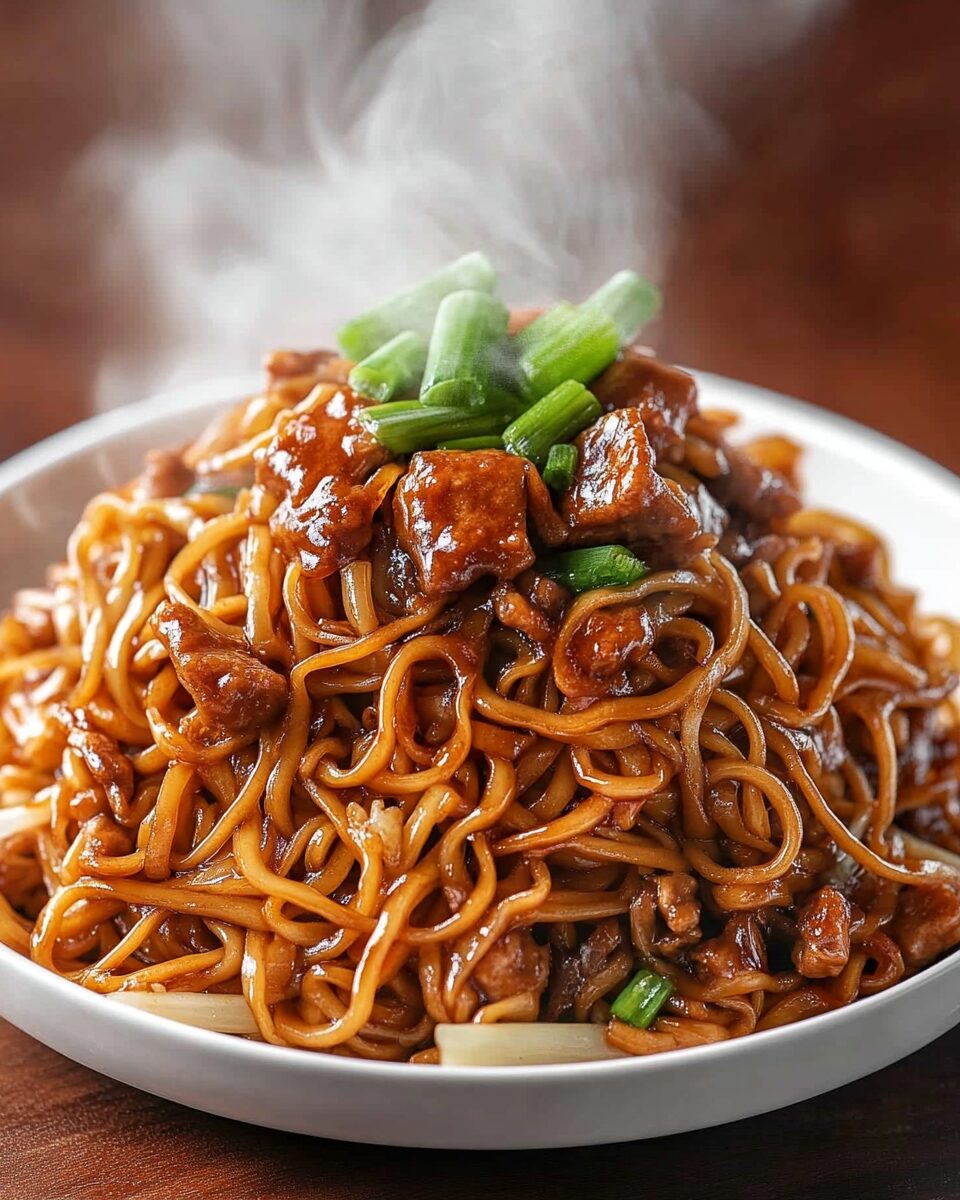The beauty of Shanghai Fried Noodles lies in their bold simplicity thick, chewy wheat noodles wok-fried with tender pork, fragrant shiitake mushrooms, and crisp napa cabbage. Tossed in a rich, savory sauce with hints of soy, vinegar, and sesame, each bite delivers a harmony of umami flavor.
This dish is the ultimate comfort meal warm, satisfying, and incredibly easy to prepare in just under 30 minutes. Whether you’re whipping it up for a weeknight dinner or serving guests something special, Shanghai Fried Noodles bring restaurant-quality flavor to your own kitchen with minimal fuss.
Full Recipe:
Ingredients:
-
1 lb fresh thick wheat noodles (or substitute with udon noodles)
-
½ lb pork loin, thinly sliced into 1 cm wide strips
-
3 cups Napa cabbage, chopped
-
½ cup shiitake mushrooms, sliced
-
1 cup green onions, sliced into 1-inch pieces
-
3 cloves garlic, minced
-
2 tablespoon vegetable oil (or any neutral oil)
Pork Marinade:
-
2 teaspoon soy sauce
-
2 teaspoon cornstarch
-
1 tablespoon neutral oil
-
1 teaspoon Shaoxing wine (or dry sherry)
-
⅛ teaspoon white pepper
Noodle Sauce:
-
2 tablespoon dark soy sauce
-
1 tablespoon regular soy sauce
-
1 tablespoon oyster sauce
-
1 tablespoon Chinese black vinegar (or rice vinegar)
-
½ tablespoon Shaoxing wine (or dry sherry)
-
1 teaspoon sugar
-
1 teaspoon sesame oil (optional)
-
½ tablespoon cornstarch
-
½ cup unsalted chicken stock
Directions:
-
Thinly slice the pork loin and marinate it in soy sauce, cornstarch, oil, Shaoxing wine, and pepper for 20 minutes.
-
In a small bowl, mix all noodle sauce ingredients. Set aside.
-
In a pot of boiling water, blanch noodles for 2 minutes until just cooked. Rinse under cold water and shake off excess water.
-
In a large skillet or wok, heat the oil over medium-high heat. Add garlic and marinated pork. Stir-fry until pork is 75% cooked.
-
Add chopped napa cabbage, mushrooms, and green onions. Stir-fry until softened.
-
Add noodles and noodle sauce. Toss everything together until noodles are well coated and the sauce is mostly evaporated. Serve hot and enjoy!
Prep Time: 20 minutes | Cooking Time: 7 minutes | Total Time: 27 minutes
Kcal: 546 kcal | Servings: 4 servings
A Deep Dive into Shanghai Fried Noodles: Flavor, Culture, and Cooking Wisdom
When it comes to comforting Chinese cuisine, few dishes rival the soul-satisfying simplicity and savory richness of Shanghai Fried Noodles (上海粗炒面 / Cu Chao Mian). This dish is beloved not just in its namesake city but across China and beyond. It’s one of those timeless recipes that strikes a balance between robust flavor, easy preparation, and nostalgic comfort making it a favorite among home cooks and restaurant-goers alike.
In this article, we explore the history, cultural significance, flavor profile, cooking tips, modern-day appeal, variations, and serving suggestions of this popular noodle dish. Whether you’re a seasoned chef or an enthusiastic home cook, you’ll come away with a new appreciation for this deceptively simple recipe.
The Origins: A Taste of Shanghai’s Culinary Heritage
Shanghai, a coastal metropolis that has long served as a gateway between East and West, boasts a unique culinary scene influenced by its proximity to Jiangsu and Zhejiang provinces. Shanghai Fried Noodles are a classic staple of Hu cuisine, characterized by moderate sweetness, light seasoning, and a focus on fresh ingredients.
This noodle dish is deeply rooted in home-style cooking and traditional street food. While it may not carry the ceremonial weight of dishes like Peking Duck or dim sum, it’s just as iconic in its own way. Served in humble households, bustling night markets, and Michelin-starred restaurants like Din Tai Fung, Shanghai Fried Noodles have carved out a well-deserved place in Chinese culinary culture.
Flavor Profile: The Magic of Umami
The true allure of Shanghai Fried Noodles lies in its flavor: deep, savory, slightly sweet, and utterly umami-packed. That richness is achieved through a combination of soy sauce (light and dark), oyster sauce, Shaoxing wine, and aromatic ingredients like garlic and green onions. These condiments create a luscious sauce that coats the thick wheat noodles evenly.
What really elevates the dish is its harmony. The chewiness of the noodles contrasts perfectly with tender slices of marinated pork and the gentle crunch of napa cabbage. Shiitake mushrooms add an earthy undertone, while green onions provide brightness and balance.
There’s no overpowering spice or heavy oil. Instead, the flavors meld into something that feels more than the sum of its parts comforting, familiar, and incredibly satisfying.
Why Home Cooks Love It
One of the main reasons Shanghai Fried Noodles are so beloved by home cooks is because they are:
-
Quick to prepare: The whole dish comes together in under 30 minutes, making it ideal for weeknights.
-
Customizable: You can swap out proteins, veggies, and sauces to fit dietary preferences.
-
Pantry-friendly: Most of the seasonings are staples in any Asian-inspired kitchen.
-
One-pan meal: Less mess, less stress what’s not to love?
It also doesn’t require any complicated techniques. If you’ve got a wok or a sturdy non-stick skillet, you’re halfway there. The key is in the prep having your ingredients ready and your sauce pre-mixed makes the cooking process smooth and enjoyable.
Pro Cooking Tips for Restaurant-Style Results
If you’re aiming to replicate the smoky, savory noodles from your favorite Chinese restaurant, here are a few expert tips:
-
Use fresh thick noodles
The signature texture of Shanghai Fried Noodles comes from thick wheat noodles. Look for these in the refrigerated section of Asian supermarkets. If unavailable, udon noodles are a great substitute. -
Velvet the meat
Marinating pork in soy sauce, oil, and cornstarch helps lock in moisture and keeps the meat tender when stir-fried. -
Don’t overcook the noodles
Par-cook them until just al dente, then rinse with cold water. This stops the cooking process and gives you that chewy texture. -
High heat is key
Use medium-high to high heat when stir-frying to get the slightly charred, smoky flavor characteristic of wok cooking. -
Toss, don’t stir
When combining the noodles with sauce and other ingredients, toss rather than stir vigorously. This prevents the noodles from breaking and keeps the dish looking beautiful.
Common Variations
As with any classic dish, Shanghai Fried Noodles have evolved into multiple variations to suit different tastes and diets. Here are a few you can try:
-
Vegetarian/Vegan: Replace pork with extra-firm tofu or tempeh and use vegetarian oyster sauce. Vegetable broth can replace chicken stock.
-
Gluten-Free: Use gluten-free soy sauce (like tamari), rice vinegar instead of black vinegar, and gluten-free noodles such as rice noodles or sweet potato starch noodles.
-
Seafood Version: Swap pork for shrimp or scallops for a briny twist. Be sure to adjust cooking times to avoid overcooking the seafood.
-
Beef or Chicken Substitute: Thinly sliced flank steak or chicken thighs work beautifully and pair well with the savory sauce.
-
Spicy Kick: Add a drizzle of chili oil or a spoonful of Doubanjiang (fermented chili bean paste) if you want a spicier profile.
Perfect Pairings and Serving Ideas
While this noodle dish is filling enough to stand on its own, it can also be part of a larger Chinese-style meal. Here are some complementary dishes to round out your table:
-
Appetizers: Pork and cabbage dumplings, cold cucumber salad, or scallion pancakes
-
Vegetables: Garlic green beans, bok choy in oyster sauce, or stir-fried snow pea leaves
-
Proteins: Mongolian chicken, honey walnut shrimp, or Chinese braised tofu
-
Drinks: Jasmine tea, iced oolong, or a crisp lager
As for presentation, serve the noodles in a shallow bowl with a sprinkling of sliced green onions on top. A dash of toasted sesame seeds or chili flakes adds a gourmet touch.
Cultural Significance Beyond the Plate
Shanghai Fried Noodles are more than just a recipe they represent the daily rhythms of life in urban China. They’re the kind of dish you might find in a school lunchbox, a busy noodle stall, or on the dinner table after a long day’s work.
They also speak to Shanghai’s spirit unpretentious, dynamic, and always in motion. Despite being simple, the dish is endlessly adaptable, reflecting the city’s blend of tradition and innovation.
This dish also has a strong nostalgic pull for many Chinese families who grew up eating it. It connects generations through shared meals and kitchen rituals, preserving culinary heritage with every stir-fry.
Conclusion:
Shanghai Fried Noodles are proof that delicious food doesn’t have to be complicated. With just a few pantry ingredients, a bit of prep, and a hot pan, you can bring a taste of Shanghai into your home. Whether you’re introducing it to your readers as a weeknight go to or elevating it with gourmet twists, this dish always delivers on comfort, flavor, and satisfaction.
So next time you’re in the mood for something hearty, homey, and wonderfully umami, give Shanghai Fried Noodles a try. They might just become your new favorite recipe to whip up again and again.






